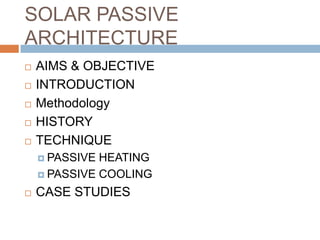Solar passive architecture
•Descargar como PPTX, PDF•
41 recomendaciones•21,846 vistas
a brief of solar passive architecture
Denunciar
Compartir
Denunciar
Compartir

Recomendados
Más contenido relacionado
La actualidad más candente
La actualidad más candente (20)
Composite climate and aurabindo ashramam,new delhi

Composite climate and aurabindo ashramam,new delhi
Degree College and Hill Complex, Leh, Himachal Pradesh

Degree College and Hill Complex, Leh, Himachal Pradesh
passive design strategies in composite & warm-humid climates.

passive design strategies in composite & warm-humid climates.
Climate responsive architecture and PEDA literature study 

Climate responsive architecture and PEDA literature study
Destacado (6)
Similar a Solar passive architecture
Similar a Solar passive architecture (20)
Sustainable Design Part Three: The Basic Principles of Passive Design

Sustainable Design Part Three: The Basic Principles of Passive Design
Day 5:From Passive Design, Energy Audit to Value Engineering: Introduction to...

Day 5:From Passive Design, Energy Audit to Value Engineering: Introduction to...
The Passive Solar of Yazd: Reflections and Performance Evaluation after 10 Ye...

The Passive Solar of Yazd: Reflections and Performance Evaluation after 10 Ye...
Sustainable Design Part Two: Climate Related Issues

Sustainable Design Part Two: Climate Related Issues
Solar passive architecture
- 1. SOLAR PASSIVE ARCHITECTURE AIMS & OBJECTIVE INTRODUCTION Methodology HISTORY TECHNIQUE PASSIVE HEATING PASSIVE COOLING CASE STUDIES
- 2. Aims & Objective AIM: To study different types of solar architectural and constructional techniques for designing different buildings and conclude the result. OBJECTIVE: To promote energy efficient building design ,i.e. to minimize energy use and negative environment effect of building To maximize use of renewable and natural resources in building environment Building Construction with optimum use of solar energy Thermal comfort for the inhabitants To reduce maintenance cost.
- 3. Methodology Research on Solar Passive features Collect Definition of various terminology used in it. Case studies of building in different climatic zones to understand the importance and usefulness of solar passive design features. Conclusion
- 4. INTRODUCTION Passive design is design that does not require mechanical heating or cooling. Buildings that are passively designed take advantage of natural energy flows to maintain thermal comfort. When sunlight strikes a building, the building materials can reflect, transmit, or absorb the solar radiation. Additionally, the heat produced by the sun causes air movement that can be predictable in designed spaces. These basic responses to solar heat lead to design elements, material choices and placements that can provide heating and cooling effects in a building.
- 5. HISTORY: 5TH CENTURY The ancient Greeks planned whole cities in Greece, to allow every homeowner access to sunlight during winter to warm their homes. By running the streets in a checkerboard pattern running east west and north-south pattern every home could face south, permitting the winter sun to flow into the house throughout the day. The Romans used it as their south-facing rooms. They became much hotter in winter than similarly oriented Greek homes because the Romans covered their window spaces with mica or glass while the Greeks did not.
- 6. Passive heating Two primary elements of passive solar heating are - South facing glass Thermal mass to absorb, store, and distribute heat There are three approaches to passive systems direct gain, indirect gain (trombe wall), and isolated gain.
- 7. Passive Cooling Passive solar cooling can reduce or even eliminate the need for air conditioning in homes. Cross Ventilation Wing Walls Thermal Chimney Other Ventilating Strategies
- 9. Case Studies Anokhi Industries, Jaipur By Nimeshpatel Torrent Research Building, Ahmedabad Youth Hostel, Jodhpur by Vinod Gupta IIHMR, JAIPUR HEMURAJA HOTEL,SHIMLA